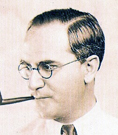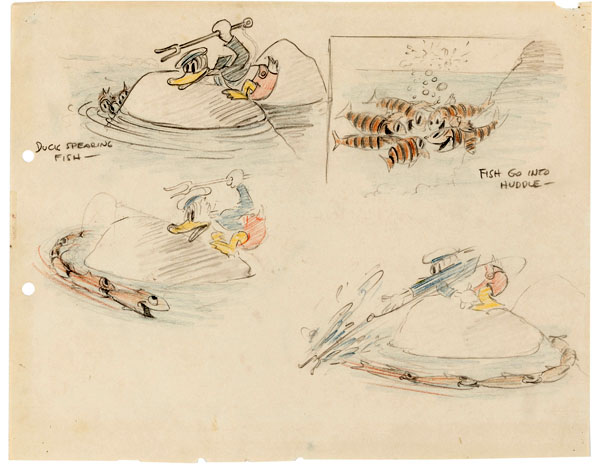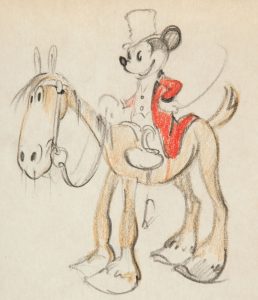Suspended Animation #283

Ferdinand Horvath gag drawing for “The Practical Pig”
Last week I talked about Ferdinand Horvath who among other animation credits worked at the Disney Studios from 1934-1937 on everything from advertising to illustrations for a pop-up book to painting backgrounds and doing layouts to constructing three dimensional models (such as making a windmill for study for The Old Mill) to character designs and gags for over fifty Silly Symphonies and Mickey Mouse shorts.
Among Horvath’s personal papers was a transcription of a lecture he had given for the artists at the Disney Studios in 1937. For historical purposes — and to bring further recognition to this often un-recognized contributor to the magic of Disney during one of its brightest periods — I am reproducing it here:
SURPRISE IN GAGS
By Ferdinand H. Horvath
February 22, 1937
In my modest opinion the most effective gags are those that will take the audience by complete surprise. The absurdity of the situation is an important factor.

Ferdinand Horvath
He reaches the bottom and without much fumbling, pulls out a plug. The flood waters start to whirl and to drain off rapidly in the best bathtub fashion, and the water running from beneath the ark leaves it high and dry atop a convenient cliff. I have never seen any gag yet in all these years that went over in a bigger way.
This in my modest opinion, is a typical example of a surprise gag: it seems logical, there seems nothing impossible about it, it is easily put over, clearly comprehensible to anyone, and yet the audience would expect anything else in the world to happen but that. There was no prop visible that would have given the gag away. It is for this reason that I think that gags of this sort are always superior to gags that necessarily need a lot of planting.
Gags around convenient props that naturally lend themselves to gag situations are more or less anticipated by the audience. Take a sack of potatoes spilled on the cellar floor, and you will expect some character to take a spill when coming in contact with them. Flypaper ditto…precariously balanced dishes…garden rake to be stepped upon.

Horvath sketches for the unproduced “MIckey’s Sea Monster”
Referring to some outstanding gag sequences, which were also mentioned in the “gag tip sheet”, as for instance Pluto’s skating sequence, Mickey with the rubber nipple, and Pluto’s flypaper sequence-all of these in my modest opinion are only mildly funny as gags themselves but they do offer good chances to the animator. However it depends on the animation whether a sequence of this sort will appear funny or not. Pluto is known as a clumsy dog.
Add Pluto, plus skates, plus ice-and it takes no imagination to expect him to slide about, tumble, and do most of the things he actually did. Introduce Pluto and the flypaper and you know that he is apt to get tangled up with it. Anticipation gratified to the nth degree. Mickey with the overworked nipple gag is another example.
It has become more or less a rule to take any awkward character to place him near enough to something that might trip him, or punch him or cause him other bodily discomforts-the audience will anticipate such, and it will be dished out to them ninety-nine times out of a hundred.
Good surprise gags, well timed, and not being touched off to order when the audience expects it—are laugh getters, because they keep you on edge in expectant mood, they keep you guessing and fool you in the end. (As a fine example I want to mention the little pig unexpectedly reopening the door to pull the “Welcome” mat in.)
Take a gag situation in one of our recent pictures (The Clock Cleaners-which at the writing of these lines has not been released yet). The Goof, after being knocked coocoo by too much Liberty, walks in a daze over exposed scaffolding, narrow ledges, etc. He finally walks toward the camera on a horizontal ladder, on which very evidently one of the rungs is missing.

“Polar Trappers” boards attributed to Horvath
Everybody chuckles in advance waiting for the Goof to step into space when he will have advanced far enough to set his foot on the missing rung. Sure enough the Goof does exactly that. It is funny as it is, because the whole sequence is so very well animated, and it surely won’t misfire, but in my modest opinion, we passed up a completely ideal surprise gag situation. It might have been so much funnier if one of the rungs, two or three notches ahead of the gaping hole would have given away, and the Goof would have dropped quite unexpectedly.
Or—after stepping safely over the hole caused by the previously established missing rung when naturally everybody expected him to drop into space, have him negotiate this dangerous spot successfully, keep him going for one or two more steps and then have a rung break afterwards when nobody would expect it.
Here would be surprise, because people kind of expect him to fall where he won’t. There would be a laugh at being knowingly kidded, and then there would be immediately another laugh-probably a much heartier laugh, after the Goof promptly broke through when everybody thought him safe. This, I believe illustrates clearly how a gag can be improved by its unexpectedness and correct timing.
Outline No. 10 dealing the Fox Hunt pointed out as an example one of my gags in that picture: the fox, hard pressed by the pack of dumb hounds, suddenly slides to a top (I hope without screeching brakes this time), and starts to scratch.
The dogs do the same. If I am not dead wrong—this gag should get a laugh because it comes as a complete surprise, is natural action and totally absurd at the same time. The audience does expect the fox to outwit the pack, to dive, to dodge, to double back and trick the dogs in numerous ways but they will hardly expect him to play follow the leader.



 Jim Korkis is an internationally respected animation historian who in recent years has devoted his attention to the many worlds of Disney. He was a columnist for a variety of animation magazines. With his former writing partner, John Cawley, he authored several animation related books including The Encyclopedia of Cartoon Superstars, How to Create Animation, Cartoon Confidential and Get Animated’s Animation Art Buyer’s Guide. He taught animation classes at the Disney Institute in Florida as well as instructing classes on acting and animation history for Disney Feature Animation: Florida.
Jim Korkis is an internationally respected animation historian who in recent years has devoted his attention to the many worlds of Disney. He was a columnist for a variety of animation magazines. With his former writing partner, John Cawley, he authored several animation related books including The Encyclopedia of Cartoon Superstars, How to Create Animation, Cartoon Confidential and Get Animated’s Animation Art Buyer’s Guide. He taught animation classes at the Disney Institute in Florida as well as instructing classes on acting and animation history for Disney Feature Animation: Florida.




















































Horvath’s remarks about surprise as a logical defiance of expectations echo many writings on aesthetics in general and classical music in particular. For example, musicologist Hugh MacDonald wrote in BEETHOVEN’S CENTURY (2008):
“…[T]he power to surprise has always been recognised as a principal ingredient in Beethoven’s supremacy as a composer. By definition surprise defies expectation and therefore logic. But surprise only works in a context of expectation, hence the balance in the best music between what we can predict and what we cannot.”
Leonard Bernstein made the same point in one of his televised Young People’s Concerts on “Humour in Music”, in which he introduced his young audience to the word “incongruous”. He also mentioned Mickey Mouse, Donald Duck, Pluto, Alice in Wonderland, and several of the pieces in Fantasia.
I suppose in 1937 many music lovers would have balked at comparing the creative process behind the gags in a Mickey Mouse cartoon to that of Beethoven composing a symphony. But it seems perfectly reasonable to me.
It’s interesting that Horvath’s observations on gags mirrors the observations of Tex Avery that the best way to make an audience laugh was to surprise them by doing something they didn’t expect you to do. But because of the image Disney had cultivated by the mid-1930s, especially with Mickey, the studio was constrained in following through on what Hovath said. You could offer up the unexpected as a gag, but only within certain controlled parameters (i.e. – Avery’s gag about a frog ‘croaking’ was never going to make it into a Walt Disney cartoon). That, in turn, tended to bland out the Disney shorts, and why the freer use of the unexpected at the Schlesinger studio by the end of the 1930s was so welcome.
Buster Keaton remarked in a late interview, with Studs Terkel I believe: “I always liked to make audiences think they’d outsmart me – and then I’d double-cross ’em.” This is illustrated in the great documentary “Buster Keaton: A Hard Act to Follow” with the use of a great surprise gag from his masterly short “One Week”.